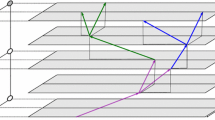Abstract
When directed percolation in a bond percolation process does not occur, any path to infinity on the open bonds will zigzag back and forth through the lattice. Backbends are the portions of the zigzags that go against the percolation direction. They are important in the physical problem of particle transport in random media in the presence of a field, as they act to limit particle flow through the medium. The critical probability for percolation along directed paths with backbends no longer than a given length n is defined as p n. We prove that (p n) is strictly decreasing and converges to the critical probability for undirected percolation p c. We also investigate some variants of the basic model, such as by replacing the standard d-dimensional cubic lattice with a (d−1)-dimensional slab or with a Bethe lattice; and we discuss the mathematical consequences of alternative ways to formalize the physical concepts of “percolation” and “backbend.”
Similar content being viewed by others
REFERENCES
M. Aizenman and G. Grimmett, Strict monotonicity for critical points in percolation and ferromagnetic models, J. Stat. Phys. 63:817–835 (1991).
M. Barma and R. Ramaswamy, On backbends on percolation backbones, J. Phys. A: Math. Gen. 19:L605-L611 (1986).
R. Durrett, Oriented percolation in two dimensions, Ann. Prob. 12:999–1040 (1984).
R. Durrett, Lecure notes on particle systems and percolation (Wadsworth & Brooks/Cole, Pacific Grove, California, 1988).
A. Gandolfi, M. S. Keane, and C. M. Newman, Uniqueness of the infinite component in a random graph with applications to percolation and spin glasses, Prob. Th. Rel. Fields 92:511–527 (1992).
G. R. Grimmett, Percolation (Springer-Verlag, New York, 1989).
G. R. Grimmett, Percolation and Disordered Systems. Ecole d'été de Probabilités de Saint-Flour, XXVI (Springer LNM 1665, 1997).
T. M. Liggett, R. H. Schonmann, and A. M. Stacey, Domination by product measures, Ann. Probab. 25:71–95 (1997).
M. V. Menshikov, Quantitative estimates and rigorous inequalities for critical points of a graph and its subgraphs, Theory Prob. Appl. 32:544–547 (1987).
C. J. Mode, Multitype Branching Processes: Theory and Applications (American Elsevier Publishing Company, New York, 1971).
R. Ramaswamy and M. Barma, Transport in random networks in a field: Interacting particles, J. Phys. A: Math. Gen. 20:2973–2987 (1987).
A. Stacey, Bounds on the critical probability in oriented percolation models (Ph.D. thesis, University of Cambridge, 1994).
J. C. Wierman, Bond percolation on honeycomb and triangular lattices, Adv. Appl. Prob. 13:298–313 (1981).
Author information
Authors and Affiliations
Rights and permissions
About this article
Cite this article
Roy, R., Sarkar, A. & White, D.G. Backbends in Directed Percolation. Journal of Statistical Physics 91, 889–908 (1998). https://doi.org/10.1023/A:1023075815581
Issue Date:
DOI: https://doi.org/10.1023/A:1023075815581



